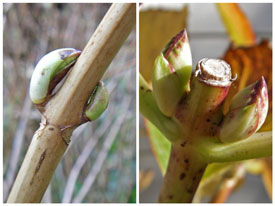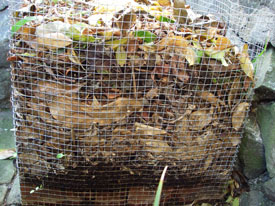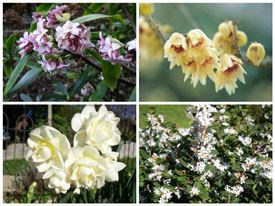Beyond the shortest day
July 2014
Winter - chilly mornings, long shadows, wet lawns, and little time to work in the garden except the weekends - if the weather is kind. But there is so much that needs doing. Every weekend I have a list as long as my arm. The shortest day has been and gone, the leaves have fallen from the deciduous trees, so it's time to get pruning.
The antique colours of my mophead hydrangea flowers have faded to brown and the leaves have fallen. I prefer to prune my hydrangeas every year to control their size in my small garden but it is not entirely necessary. Unpruned hydrangeas will still flower just as well.
For good flowering next season, find the big fat flower buds usually sitting in pairs proud on the stem. There may be two or three pairs but I usually prune to the lowest one which means the bush won't get too crowded and tall, and the flowers will be bigger. I also prune away any low spreading branches that take up space and weak spindly branches, all preferably to the base of the plant. I also thin out a few branches from the middle if the bush looks too crowded.
If you want more hydrangea plants, use these woody prunings which are easy to grow. Make a cutting, 15 to 20cm long, by cutting below a node (where the leaves attach) and remove any buds from there, then another cut above a node preferably with the thinner leaf buds, not flower buds. Then just push into some gritty free-draining soil in the garden or in a pot and leave alone. You'll know if they've grown roots when the buds flourish in spring.
I've put my vege garden to bed with a dressing of horse manure and a scattering of mustard seed for a green crop. I wish I'd thought to plant some leeks after I'd dug the potatoes in January so I could have them for winter soups but it's too late now - leeks planted now wouldn't be ready till late spring.
There are plenty of leaves to gather up for the compost heap. The advantage of deciduous trees over evergreens is that you only have to collect the leaves a couple of times in autumn and winter and the job is done - evergreens drop leaves all year round. Still, I’m not complaining - I can see in my wire bins the rich dark leaf mould starting to form which I can dig out and use in spring.
What winter may lack in sunlight and flowers is more than made up for in fragrance. There are so many plants with unassuming flowers that fill winter gardens with fragrance - daphne, wintersweet, osmanthus, witchhazel, luculia, early jonquils and even some azaleas to name but a few. In my dream garden I envisage a garden pathway bordered with fragrant plants that can be enjoyed even on the darkest winter night – a visual symphony by smell!
11-Jul-2014

Hydrangea leaf buds and flower bu

Leaf mould

Daphne, wintersweet, osmanthus, Earlicheer (clockwise from top left)

